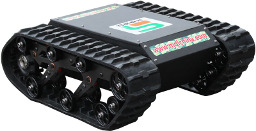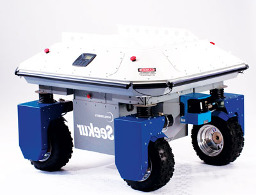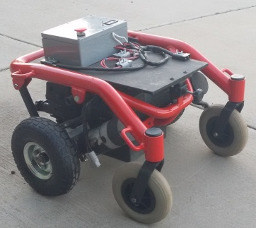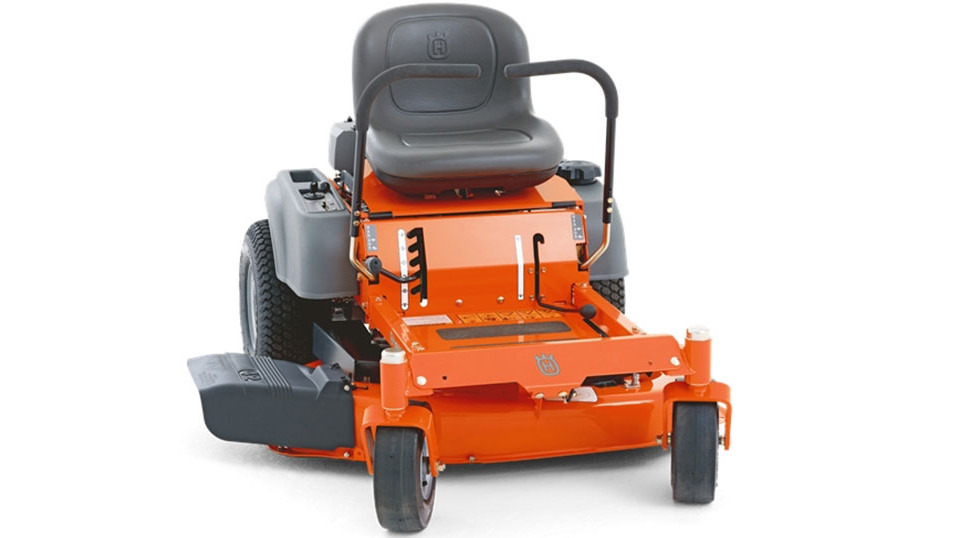Suitable agricultural drive mechanisms
Robots with special needs.
Tracked robots

These spread the load of the rover over the whole of the tracked bottom, so when driven straight, cause minimal disruption. However when they turn, they will churn up earth or vegetation.
They also prone to jamming. Branches and wire can easily be tangled in the tracks. Not so much of a problem if there are teams of soldiers or earth-moving operators ready to free or untangle the tracks, but not so good for a robot designed to operate unattended. Wheeled robots are not immune to these things, but there are simply less places for foreign objects to tangle or jam.
Swerve drive

Wheels can turn any direction and move independently. Like Ackermann steering, all axle lines intersect at the turning point, but the intersection point can be anywhere - even within the robot boundary. Hence the robot can turn on the spot with maximum versatility and minimum ground disruption.
Differential drive robots

The drive wheels are driven differently, and the turning point is anywhere on the main axle line. Casters on the front or back just swivel to follow the movement and take the load. The tyres might rotate on the spot, but don't actually skid sideways. Disruption to the earth or vegetation is low.
Discussion
The mainstream applications for tracked vehicles are
-
earth moving vehicles - such as bulldozers which have to spread a very heavy load over a potentially unstable surface, and need to extreme traction to push dirt around;
military tanks - which spread a very heavy load over a large surface as possible and require high traction; and
snow vehicles - which require traction on a soft surface.
On the other hand, there are two mainstream vehicle types which are designed to drive over vegetation with minimal damage or disturbance
-
golf cars, Ackermann steering vehicles which can be driven all over immaculate lawns while minimising damage; and
ride-on lawnmowers - (the larger ones are generally differential drive) which are highly manoeuvrable and also driven on quality lawns with minimal damage.
This should give us a clue as to what drive forms are suitable for agricultural robots. Robots are about new technology but they do not change laws of physics, and generations of smart people have solved many agricultural problems already.
Tracked vehicles are good at getting into inaccessible places, but the majority of farm land is quite accessible (goat farms notwithstanding). Tracked vehicles work well on steep slopes, but golf-cars and zero-turn lawnmowers also have a very low centre of gravity.
In short, farmers care about the protection of their vegetation. Chewing up crops damages the crops, and results in a lower yield. A pasture that gets chewed up is a pasture which will be covered with weeds next year, which will mean lower productivity, more work and possibly having to use use more poison. A tracked robot is likely to create more work than it saves.
Further, tracked vehicles are inefficient - they need more energy to drive them. A fossil-fuelled tracked vehicle will be more expensive to run (and pollute more), and a battery powered vehicle will not last as long between recharges.
A swerve drive robot may seem like a good alternative, but these will require eight motors, and there is no way that the complex drive mechanisms can complete with a simple differential drive in cost, reliability, or robustness. They will simply be too expensive to build, and too easy to break - particularly in a testing phase where they will run into things and fall into negative obstacles (ie holes).
The shape of golf cars and zero-turn (ie differential drive) ride-mowers should also give some clues about how to build agrobots.
-
Firstly, they have very wide tyres with very little tread - that is, they spread the load as far as possible without using tracks. This is how they minimise vegetation damage.
Secondly, they have a very low centre of gravity, enabling them to work well on steep slopes. For safety reasons, it is generally recommended to make ride-mowers face down the slope to avoid rolling, but they can still operate on very steep slopes in any orientation if acceleration is controlled. And let's face it - tipping a vehicle is a lot less scary if you are not actually on it.
There are disadvantages of wide smooth tyres too - the wide smooth tyres mean that slippage will be a serious consideration - particularly on slopes, making wheel encoder / dead-reckoning navigation almost useless. Navigation algorithms have to take this into account.
In summary, agricultural roboticists can learn from the lessons of others. High manoeuvrability situations call for differential drive, low manoeuvrability situations call for Ackermann drive. If operating on grass, both call for wide, low tread tyres with minimal slippage. Golf cars and zero-turn lawn mowers win this one. High-traction (ie high disturbance) tyres should be reserved for pulling a plough.
Cool links
-
Get Allegrobotics updates on twitter
IBEX tracked agricultural robot - chewing up the English moors one skid-mark at a time.
SwarmFarm - an interesting exception which uses a reverse pendulum swerve drive on a single wheel.
QUT spray vehicle - converted agricultural runabout.
Weedinator - a semi-swerve drive by Goat Industries. This is a cool machine, but the use of stepper motors lowers efficiency, and the battery life will be much reduced, requiring an on-board dinosaur-powered generator.
Leave a comment
Think I might have solved your problem? Ninety-nine problems, but your robot ain't one? Say so ..




